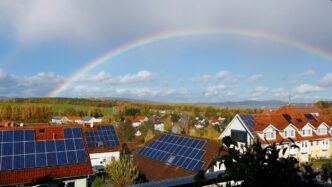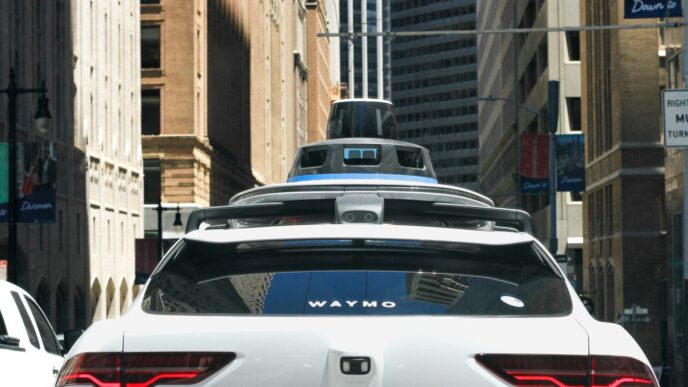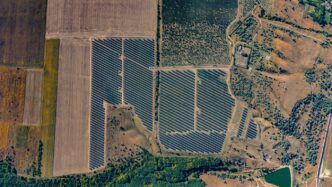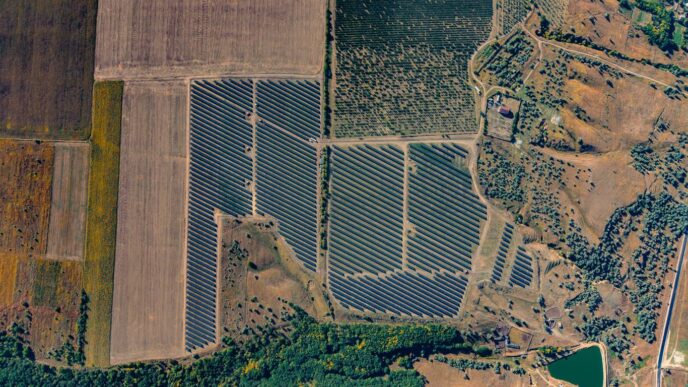We all know the sun can be a bit dramatic sometimes, right? Well, imagine a really, really big dramatic moment from the sun. We’re talking about a massive solar storm, the kind that hasn’t happened in a long time. This article looks at what could happen if a storm like that hits us, especially what will happen to Earth in 2025. It’s not just about pretty lights in the sky; it’s about how it could mess with our technology and our lives.
Key Takeaways
- A solar storm similar to the 1859 Carrington Event could cause widespread damage to our technology, including satellites.
- New simulations suggest that even satellites in low Earth orbit might not be safe from a major solar storm.
- Past solar events, like the one in May 2024, have already shown how they can disrupt systems like GPS and cost farmers a lot of money.
- Experts believe a Carrington-level storm is not a matter of ‘if’ but ‘when’, and our increasing reliance on technology makes us more vulnerable.
- Preparing for such events involves learning from past storms, practicing responses, and building more resilient systems.
Understanding the Threat of a Major Solar Storm
So, what exactly are we talking about when we mention a ‘major solar storm’? It’s not just some abstract scientific concept; it’s a real, powerful event originating from our Sun that could seriously mess with our lives here on Earth. Think of it like a massive explosion on the Sun’s surface, hurling a huge cloud of charged particles and radiation our way.
What Will Happen to Earth in 2025: The Carrington Event Analogy
To get a handle on the potential impact, scientists often look back to the Carrington Event of 1859. This was the biggest solar storm we’ve ever recorded. A British astronomer named Richard Carrington saw a massive flash on the Sun, and shortly after, the Earth’s magnetic field went haywire for days. People saw auroras, those beautiful light shows, as far south as the Caribbean! But it wasn’t all pretty lights; the telegraph systems at the time went crazy, with operators getting shocks and some equipment catching fire. If an event like that happened today, with our heavy reliance on technology, the consequences would be far more severe. We’re talking about potential disruptions that could make that 1859 telegraph chaos look like a minor inconvenience.
The Science Behind Solar Flares and Coronal Mass Ejections
These solar storms are usually kicked off by two main phenomena: solar flares and Coronal Mass Ejections (CMEs). A solar flare is a sudden burst of energy and radiation from the Sun’s surface. These travel at nearly the speed of light, so they hit us fast. Then, there are CMEs, which are massive clouds of plasma and magnetic field that get ejected from the Sun. These are slower, taking hours to reach Earth, but they carry a huge amount of energy and can really stir up our planet’s magnetic field, causing geomagnetic storms. It’s like getting hit by a fast, intense radiation wave followed by a slower, but much heavier, punch of charged particles.
Why a Major Solar Storm is an ‘Inevitable’ Event
Scientists don’t just guess that these storms will happen; they know it’s a matter of ‘when,’ not ‘if.’ The Sun has a cycle, and while we can’t predict the exact timing of a massive storm, history shows they occur. Some studies suggest a Carrington-level event happens, on average, every 500 years. Given that the last one was in 1859, the odds of another one happening this century are significant. Plus, with more and more satellites being launched into orbit, the potential for damage increases. It’s like living in a city that’s due for a big earthquake; you can’t stop it, but you can prepare for it. Recent solar activity, like the geomagnetic storm in May 2024, gave us a small preview, disrupting GPS and costing farmers a lot of money. This is why understanding the threat is the first step in preparing for what might come, even potentially impacting areas like Southern California with flooding risks [69eb].
Simulating the Catastrophic Impact on Technology
Okay, so imagine the sun throws a massive tantrum – a solar storm so big it makes the 1859 Carrington Event look like a mild inconvenience. What happens to all the tech we rely on every single day? New simulations are painting a pretty grim picture, and honestly, it’s a bit scary.
The Vulnerability of Satellites in Orbit
First off, our satellites. We’ve got thousands of them up there, doing everything from letting us watch TV to helping us navigate. A major solar storm, especially the kind with a huge coronal mass ejection (CME), is like a giant, invisible wrecking ball. The initial blast of radiation from a solar flare can fry electronics, and then the CME itself can heat up Earth’s upper atmosphere. This makes it swell outwards, creating way more drag on satellites. Think of it like trying to fly a kite in a hurricane – the increased drag can pull satellites down, causing them to burn up or crash. No satellite is truly safe from an event of this magnitude.
Disruption to Global Communication and Navigation Systems
If satellites start failing, our communication and navigation systems go with them. GPS would likely go haywire, making it impossible for planes to land safely or for your car’s navigation to work. Mobile phone networks could go down, and internet services might become unreliable or completely unavailable. Imagine a world where you can’t call for help, can’t get directions, and can’t even check the news online. It’s a pretty isolating thought.
Potential for Widespread Power Grid Failures
This is where things get really serious for life on the ground. When a massive solar storm hits, it can induce powerful electrical currents in long conductors, like power lines. These currents can overload transformers, causing them to fail. We saw a small taste of this during a less intense storm in May 2024, which caused some disruptions. But a Carrington-level event could take down entire power grids across continents. This means no electricity for homes, hospitals, water treatment plants, or anything else that needs power. The economic fallout and societal chaos from such a widespread blackout would be immense.
Economic and Societal Repercussions
Okay, so we’ve talked about the science and the tech side of things, but what does a massive solar storm actually do to us, you know, as people living our lives? It’s not just about broken gadgets; it’s about how we live, work, and get by.
The Staggering Financial Costs of a Carrington-Level Event
Let’s get real about the money. We saw a little taste of this with the May 2024 storm. Farmers lost about $500 million because their GPS-guided machinery went haywire. That sounds like a lot, right? Well, it’s nothing compared to what a Carrington-level event could do. Studies looking at just the North American power grids suggest damages could hit $2.6 trillion. And that’s just one part of the picture. The total global cost? Experts say it’s pretty much off the charts, something we can barely wrap our heads around.
Impact on Agriculture and Essential Services
Think about your daily life. How much of it relies on technology? A lot, I bet. If satellites go down and power grids fail, it’s not just your phone that stops working. Agriculture would be hit hard. Modern farming uses GPS for planting, fertilizing, and harvesting. Without it, food production would grind to a halt. Then there are other services we just expect to work: water treatment plants, fuel distribution, emergency services. All of them depend on reliable power and communication. Imagine hospitals trying to function without consistent power or communication lines. It’s a domino effect that could quickly spiral.
Global Preparedness and Response Strategies
So, what are we doing about it? Well, people are starting to take this more seriously. There are exercises, like the ones ESA has been doing, where they simulate these worst-case scenarios. It’s like practicing for a natural disaster, but for space weather. The idea is to figure out how we’d respond, who does what, and how we can minimize the damage. It’s not about preventing the storm – we can’t do that – but about being ready to pick up the pieces afterward. This includes:
- Developing backup systems: Thinking about how to keep critical infrastructure running even if the main systems fail.
- Improving early warning: Getting better at predicting when these storms might hit so we have a little more time to prepare.
- International cooperation: Since this is a global problem, countries need to work together on response plans and sharing resources.
It’s a huge challenge, and honestly, we’re probably not as ready as we should be. But the more we practice and plan, the better our chances are when the next big one inevitably arrives.
The Sun’s Activity and Future Predictions
Recent Solar Flares and Their Intensity
So, the Sun’s been a bit feisty lately, huh? We’ve seen some pretty significant solar flares popping off. Just recently, on November 11th, 2025, there was a big one, an X5.1 class flare. That’s the strongest we’ve seen this year, and honestly, the most intense since October of last year. It came from a sunspot group, AR4274, which has been really active. This particular blast caused some serious radio blackouts over parts of Africa and Europe, messing with high-frequency communications when the sun was shining on those areas. It wasn’t a one-off, either. This same sunspot group let loose an X1.7 flare on November 9th and an X1.2 on the 10th. These weren’t just pretty light shows; they were accompanied by coronal mass ejections (CMEs) – huge clouds of plasma shot out into space. The ones from the 9th and 10th might even combine and hit Earth, potentially causing strong geomagnetic storms and, you guessed it, more auroras. And the big X5.1 flare? Its CME is also heading our way, expected to arrive around midday on November 12th. With all these CMEs potentially piling up, we might be looking at severe geomagnetic storm conditions. It’s a lot to keep track of, and frankly, a bit unnerving.
Forecasting Solar Storms and Geomagnetic Activity
Trying to predict when the Sun’s going to throw a tantrum is tricky business. Scientists use a bunch of tools and data to forecast solar storms and geomagnetic activity. They monitor sunspots, which are like the storm centers on the Sun’s surface. These dark spots are cooler areas linked to the Sun’s magnetic field, and when that field gets tangled up, it can lead to flares and CMEs. Instruments like the Solar Dynamics Observatory and the NOAA Space Weather Prediction Center keep a close eye on these events. They can detect flares almost instantly because the radiation travels at the speed of light. CMEs, however, are slower, taking hours or even days to reach Earth. The speed and size of a CME are key factors in how strong the resulting geomagnetic storm will be. The faster and bigger the CME, the more intense the storm. Based on current observations, the CME from the recent X5.1 flare is moving incredibly fast, estimated at around 1856 km/s. This speed is a major factor in predicting the potential impact on Earth’s magnetic field.
The Increasing Risk with Growing Satellite Constellations
Here’s the kicker: the more we rely on technology, the more vulnerable we become. Think about all the satellites up there right now. We’ve got communication satellites, GPS satellites, weather satellites – you name it. And the number is only going up. Projections suggest the number of satellites orbiting Earth could increase tenfold by 2050. This is where things get really concerning. A major solar storm, like the Carrington Event back in 1859, could be devastating. New simulations show that such an event today wouldn’t leave any spacecraft safe. The initial radiation burst could fry electronics, and the follow-up CMEs could cause the Earth’s upper atmosphere to swell. This swelling increases drag on satellites, potentially pulling them out of orbit to burn up or crash. It’s a complex problem because while satellites in lower orbits are somewhat protected by our atmosphere and magnetic field, a truly massive storm could overwhelm those defenses. The risk isn’t just theoretical; it’s growing with every new satellite we launch into an already crowded space environment.
Preparing for the Unforeseen Solar Event
Okay, so we’ve talked about how bad a big solar storm could be. It’s kind of like thinking about a massive earthquake or a super-storm – you hope it never happens, but you really should have a plan just in case. The thing is, scientists are pretty sure these huge solar events are going to happen again. It’s not really a ‘if’ situation, more of a ‘when’.
Lessons Learned from Past Solar Storms
We’ve actually seen some pretty wild solar activity before. Remember that big geomagnetic storm back in May 2024? It was the strongest in over two decades and gave us some amazing aurora shows. But it also messed with GPS systems and even caused problems for farmers, costing them a good chunk of change. That was just a taste, though. The Carrington Event in 1859 was way, way bigger. Back then, it caused telegraph systems to go haywire, and people saw auroras as far south as the Caribbean. Imagine that happening today with all our tech. We’ve got to look at these past events, even the smaller ones, and figure out what went wrong and what we did right.
The Importance of Simulation and Training Exercises
This is where things get serious. Scientists and engineers are doing these "tabletop exercises," basically running through worst-case scenarios on paper or computers. They’re trying to figure out exactly what would happen to our satellites and power grids if a Carrington-level storm hit. It’s a bit like how we prepare for pandemics – you practice and plan so you’re not caught completely off guard. These simulations are showing us we’re not quite ready yet, and that’s a big wake-up call. It helps identify the weak spots in our systems before a real event forces us to deal with them.
Building Resilience Against Space Weather
So, what can we actually do? It’s about making our systems tougher. Think about having backup power sources for critical infrastructure, like hospitals and communication centers. We also need better ways to protect our satellites, maybe by designing them to withstand more radiation or having ways to quickly move them out of harm’s way. It’s also about having plans in place for when things do go wrong. This includes things like having backup communication methods and making sure our supply chains for food and medicine are strong enough to handle disruptions. Preparing for space weather is really about preparing for a lot of different kinds of disasters, because many of the same steps help mitigate impacts from other disruptive scenarios. We need to get better at predicting these events too, so we have a bit more warning. The more satellites we have up there, the more we have to lose, so building resilience now is super important.
So, What’s the Takeaway for 2025?
Look, nobody can say for sure when the next big solar storm will hit, but the science is pretty clear: it’s not a matter of ‘if,’ but ‘when.’ We’ve seen how even smaller events can mess with our tech, and simulations show a major one could really knock us back. It’s kind of like preparing for a hurricane – you hope it never comes, but you’d be foolish not to have a plan. For 2025 and beyond, it means we really need to get serious about protecting our satellites and our power grids. It’s a big job, but ignoring it just isn’t an option anymore.
Frequently Asked Questions
What is a major solar storm, and why is it a concern for Earth?
A major solar storm is like a giant explosion on the Sun that sends out a huge burst of energy and particles into space. These storms, especially ones like the Carrington Event from 1859, can cause big problems for our planet. They can mess with our technology, like satellites and power lines, which we rely on a lot today.
Could a solar storm in 2025 really knock out all our satellites?
New computer simulations suggest that a storm as powerful as the Carrington Event could seriously harm or even destroy many satellites orbiting Earth. While it’s hard to say ‘all’ for sure, the risk is very high, and it would leave us without many of the services we depend on, like GPS and weather forecasting.
What happened during the Carrington Event in 1859?
In 1859, a massive solar flare happened, and the energy from it hit Earth. It caused telegraph systems to go haywire, shocking operators and even setting some on fire! People also saw amazing auroras, or Northern Lights, as far south as Cuba because the storm was so strong.
How could a solar storm affect our power grids and daily life?
A big solar storm can create electrical currents in long power lines, potentially overloading and damaging the equipment that keeps our electricity flowing. This could lead to widespread power outages, affecting everything from homes and businesses to hospitals and communication networks. It could also disrupt farming equipment and other essential services.
Are solar storms predictable?
Scientists can track the Sun’s activity and sometimes see signs of flares or storms developing. However, predicting the exact timing, strength, and direction of the most powerful storms is still very difficult. While we know they’re inevitable, knowing precisely when the next big one will hit is a major challenge.
What can we do to prepare for a major solar storm?
Preparing involves a few key things. Scientists and engineers need to keep studying the Sun and improving our ability to forecast storms. We also need to make our technology, like satellites and power grids, tougher and have backup plans in place. Practicing how we would respond to such an event, like doing drills, is also crucial to minimize the damage.














